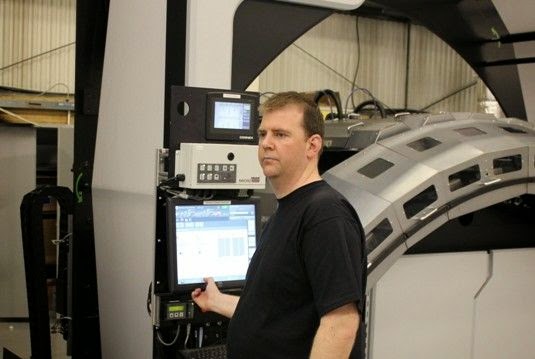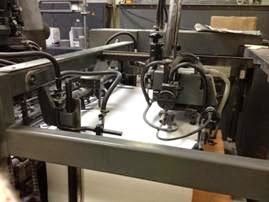Douglas Burcham reports from a recent Self-Publishing Experience Day, which included a visit to CPI’s print and book manufacturing plant.
On returning home from Chippenham last Wednesday I stopped at the WH Smiths kiosk at Reading station and felt pleased my first fiction best seller Gemini One had reached number two after my interviews on BBC and the red top daily press.
My 25,000 printed copies were a small fraction of the 500 million books, 25 million magazines and 15 million catalogues printed by the whole CPI Group each year as Europe’s largest book printer. This included a multi-million copy print run of the
Fifty Shades of Grey trilogy in 2012. The Chippenham-based firm was founded by Antony Rowe before being taken over by the CPI Group. Antony Rowe was no stranger to printing difficult books. In 1960, along with Pitman, he printed 200,000 copies of
Lady Chatterley’s Lover.
The whole
CPI Group includes many of Europe’s longest established book manufacturing companies, such as Firmin-Didot, Clausen & Bosse, Koninklijke Wohrmann and Mackays; as well as younger companies, like Antony Rowe and Buchbuecher, which have gained a reputation for innovation, specialist services and consistent quality. Each company in the group has its own history–its own character–developed through long-established relationships with national clients. This individuality is tremendously valuable–and it’s what makes the CPI Group so rich and diverse.At Antony Rowe printing works—now known simply as CPI—in Chippenham, England, I watched paper from large reels on their new, James Bond like by name, ‘Quantum’ inkjet technology printing machine whizzing by at 60 feet per second (day and night); capable of printing 5 million books annually. What a far cry from Guttenberg’s first printing press! The large HP logo on the machine bought back memories of blue air in my house when my own double-sided page HP printers fouled up while running off many draft copies of my writing. I imagined how much more spectacular a crash a ‘Quantum’ could have if the paper were to snag. The ‘Quantum’ process also gives the opportunity to introduce colour printing anywhere in a book. It does not seem too long ago daily newspapers were produced all in monochrome and I suspect more books will also go this way soon.
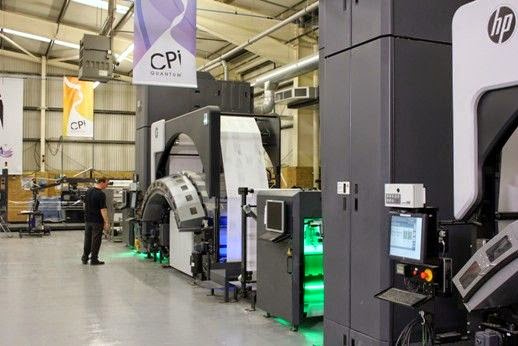
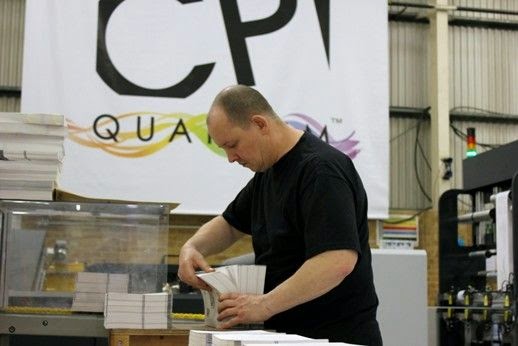 |
| (Above pics – at work with the Quantum Inkjet Machine) |
I also saw traditional lithographic machines at CPI still successfully using metre wide aluminium lithographic plates to print pages ready for perfect binding for a wide variety of mainly non-fiction new titles and also Xerox copier-based printing. I chuckled to see printing economically based on units of 8, 16 and 32 pages, to avoid those spare blank pages I hate seeing in books. It made a connection in my mind to electronic computer memory of 128mb, 256mb and 512mb, and I wondered perhaps whether there is a stronger historic link. The page units in multiples of 4; the same way you can fold a piece of paper in half, then in half again and again—doubling the number of pages each time, 4, 8, 16, 32, 64, 128 and so on. All this is strange to me in a decimal and metric world.
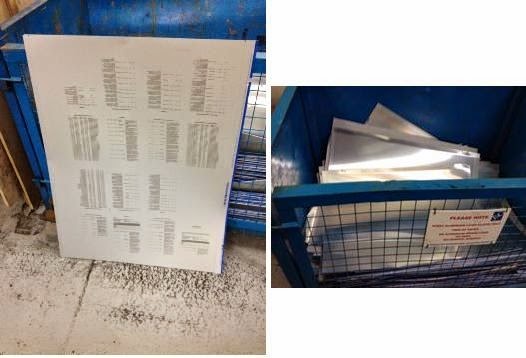 |
| (Lithographic print plates before and after the print process) |
Okay, although my bestseller in WH Smiths and BBC interviews are pure fantasy, the rest of the above earlier in the day was not! The day had been organized by Matador Publishing as a follow up to their 2nd Self Publishing Conference where potential self-publishing clients are given the chance to see books being made.
I had previously seen lithographic printing in the early 1960s. I saw the
Financial Times newspaper being printed in the 1980s in a new plant in East London, and more recently a small—relative to CPI—book preparation and digital printing set up all on one site at
York Publishing Services (YPS). YPS prepared and printed my self-published short story book
Ywnwab! for me to the very high standard I wanted, equivalent to CPI, and to the deadline time required after a start with my MS Word text nine weeks earlier. CPI says it aims never to miss a deadline—their motto—
‘good books delivered on time’ is the mantra.
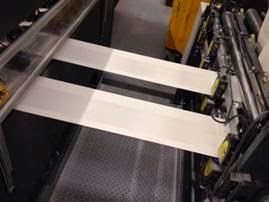 |
| (Above pics – Paper feed mechanisms) |
Given I do not really like reading e-books, I found great satisfaction and some optimism in seeing so many books being printed and the investment being made in new printing technology.
CPI also provide
self-publishing services including e-books direct to writers themselves. There is no minimum quantity because CPI can print how ever many copies the customer requires—from one to a million books. Interesting for Europe’s largest printer of books.
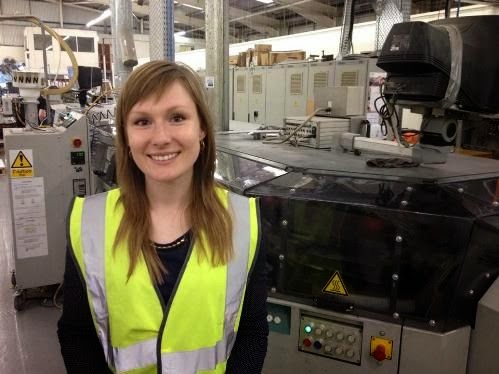 |
| (Naomi Green, Production Controller, Matador) |
After a general introduction about CPI by Dino Bishop and Joe Fearnley, a presentation was made by Naomi Green of Matador detailing all the necessary steps in self-publishing. The presentation confirmed to me the sharp divide between all the services one can have full control over in the process and the selling and marketing where one has no control over who buys and reads one’s book. Matador use CPI for printing many of their client’s books, particularly those with colour pages.
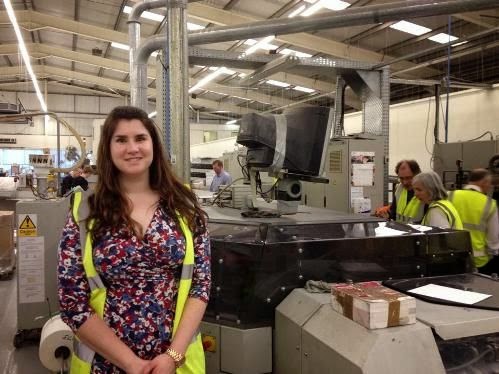 |
| (Sarah Taylor, Marketing Manager, Troubador) |
Sarah Taylor of Troubador Publishing then gave a presentation on marketing emphasizing the need for adequate lead times, six months is suggested, and setting a good foundation with the book trade side with follow up by direct efforts made mainly by the self-publishing author. Of particular interest to me were the concise book descriptions for the trade. I recalled the tremendous efforts and hard work on marketing her books put in by Polly Courtney when she described the process to those present at the Self Publishing Conference.
The whole media marketing approach could almost take all one’s time, which to me can be better spent on enjoying creative writing. I have found a good little online media book by Tony Riches;
Build Your Online Author Platform.
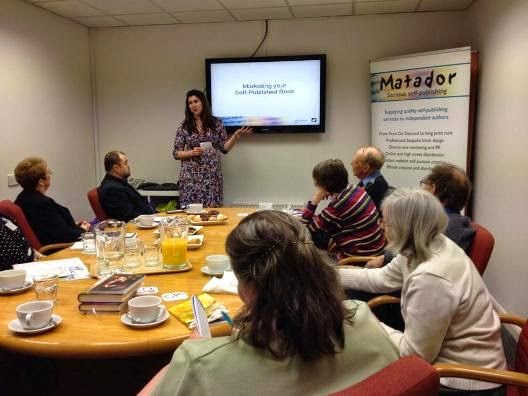 |
| (Delegates at the Marketing Session) |
As a self-publisher, it is not practical to do all the various and numerous activities. The one task I would like to contract out would be the marketing and selling side because I cannot sell for toffee and it is the one part of the writing and publishing process I enjoy least having tried to sell my first book for the last nine months. From speaking to other writers present in Chippenham for the Self-Publishing Experience Day, I do not think I am alone.
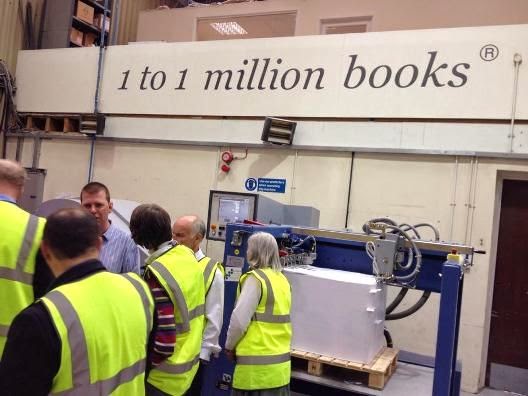 |
| (Delegates visit the CPI print floor) |
Naomi Green said one has to be clear about what one’s aims are in self-publishing. I am coming around to an aim of ‘Writing and Reading for Pleasure’ but there is still this little worry bead about wanting a best seller on sale at Reading station!
Overall, it was a very interesting and worthwhile day and I thoroughly recommended it. You can contact Matador for details of further Self-Publishing Experience Days
at this link.
The next experience day will be held on Thursday 26th June 2014 and attendance is free. Guest speaker, Alexa Whitten of The Book Refinery, will talk about her experiences of self-publishing in a session called The Self-Publishing Route.
(All above pictures courtesy of CPI and Troubador)
[Note: For those curious about the full name, the CPI initials are from the original French company and owners who started to put the group together. The names are no longer used.]
He tells me he has now passed his million draft words target and is missing the impetus the target gave to his daily writing habit. After drifting for a couple of months he has decided to split the million words into short 18,000 word chunks and to self edit and complete one of these a week. So an interlinked 50 book and 900,000 words target for completion by this time next year to keep him out of other mischief and his brain engaged. These will most likely be published as Kindle books during the year, or in a year’s time, if he can puzzle out the conversion process and covers. Also five to seven or 100,000 words of non-fiction to be self published in Kindle and hard copy as his Ywnwab! – Autumn Story-book.
 Mick Rooney – Publishing Consultant
Mick Rooney – Publishing Consultant
If you found this review or article helpful, but you’re still looking for a suitable self-publishing provider to fit your needs as an author, then I’m sure I can help. As a publishing consultant and editor of this magazine, I’ve reviewed and examined in detail more than 150 providers throughout the world like the one above. As a self-published and traditionally published author of nine books, I understand your needs on the path to publication and beyond. So, before you spend hundreds or thousands, and a great deal of your time, why not book one of my personally tailored and affordable consultation sessions today? Click here for more details.
If you would like to leave a comment on an article older than one week, please use the Blogger comment facility rather than the Facebook comment app as we do not monitor FB comments as regularly.






 Mick Rooney – Publishing Consultant
Mick Rooney – Publishing Consultant

